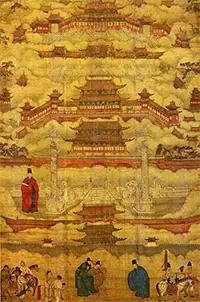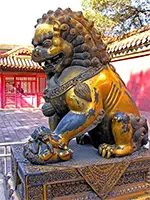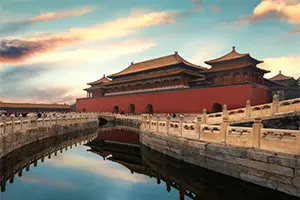The Great Wall of China
The Forbidden City is one of the world's most popular tourist attractions and one of the largest imperial palaces ever built. In all, 24 emperors called the Forbidden City home. Citizens were not allowed to enter without permission; this gave the city its name. 
The Jongle Emperor, in 1406, began construction, in conjunction with the move of the imperial capital to what is now Beijing. More than a million workers, including 100,000 craftsmen, labored for a total of 14 years in order to build the complex. Materials used for construction included stone, rare wood, and "golden bricks" (dedicated paving stones). Buildings are red and yellow. The building elements interlock and are not held together with nails (which were considered unharmonious). Adorning many buildings are animals such as dragons, lions, and phoenixes, all of which symbolize power and prestige. Lions are popular as statues as well. The rectangular complex stretches 3,153 feet from north to south and 2,470 feet from east to west. Its 980 buildings contain 8,886 rooms. Gardens, statuary, ornaments, bridges, waterways, and many other elements occupy an interior space that totals 178 acres. Surrounding it all is a wall that is anywhere from 26 to 32 feet high. Each side has a gate:
In the chaos that precipitated the demise of the Ming Dynasty and the ascendancy of the Qing Dynasty, some leaders of the Manchu and Sangui invaders burned some parts of the Forbidden City. The victorious Qing changed the names of some parts of the complex. Chinese forces lost control of the Forbidden City in 1860, when a combined English-French force occupied the massive complex during the Second Opium War. As well, coalition forces during the Boxer Rebellion became an occupation army for a time. 
In 1912, Puyi, the last Emperor of China, abdicated, ending the Qing Dynasty. He stayed in the Inner Court, but the public at large gained the use of the Outer Court. The Republic of China established the Palace Museum in 1925, and the last emperor left for good. Japanese forces invaded in 1933, and Chinese officials spirited away some of the Forbidden City's sacred belongings. Much of that was returned after World War II, although part of it went to Taiwan in the split that punctuated the advent of communism in the later 20th Century. UNESCO designated the Forbidden City a World Heritage Site in 1987. The complex is now one of the world's most visited sites, with annual visitors routinely exceeding 14 million. |
|
Social Studies for Kids
copyright 2002–2024
David White






